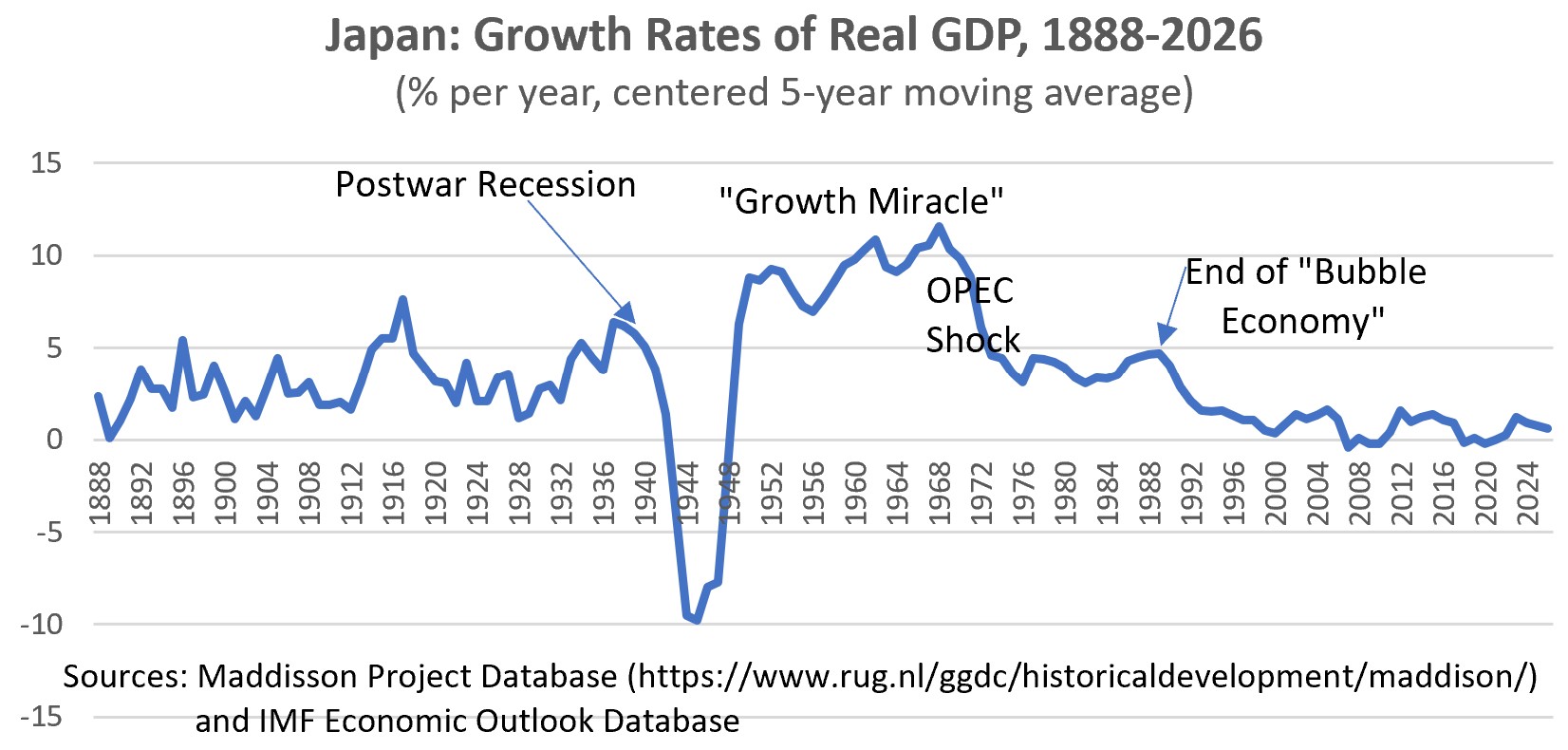|
Japan:
Rebuilding After the Bubble
Japan
Map
Japan/China
Map
I.
The Environment
A.
Little land or resources—trade dependency
B.
Crazy-Strong Work Ethic
1.
Past refrain: "We must work very hard because we are a poor
island nation." A newer Japanese term, karo shi, was
coined to mean "death by overwork," and now
families are compensated by both the government and the
employer for these deaths.
2.
Recent efforts to moderate work ethic:
Reduced
the length of the standard legal workweek from 48 to 44, and
then to 40 hours. Employees who work more hours are supposed
to be paid overtime, and there's a legal cap on how many hours
can be worked overtime. On the positive side, some firms are
shifting to a 4-day
work week to encourage employees to go home, and some
are turning off their lights at night. In
June 2018, the government passed a new labor law that
limits overtime to 100 hours per month (a lot!), but included
a loophole that allows white-collar workers to exempt
themselves from that limit.
However, at many firms, staying within legal limits is
considered a form of "disloyalty," and workers find ways
around those limits -- for example, by working without
clocking in. According to BBC,
"Nearly a quarter of Japanese companies have employees working
more than 80 hours overtime a month, often unpaid, a recent
survey found. And 12% have employees breaking the 100 hours a
month mark."
C.
Hierarchical social structure, groupism, and culture of
conformity, perhaps descended from Confucianism – a
hierarchy of family structures from the nuclear family up
to the old "Japan Inc."
D.
Poor Status of Women– According to the World
Economic Forum index, Japan ranks 121st in the world -
behind China (106), India (112), and the United Arab Emirates
(120) - in gender equality. Women hold only 5% of seats on company
boards, compared to 22% in the U.S. and more than 40% in
France, Iceland, and Norway. The current controversy is the #KuToo
movement, protesting rules that require women to wear
high heels at work - even in some assembly-line jobs.
C.
Political instability--seven prime ministers served during
1990s, and seven served during 2000-2012. Some stability
restored when Shinzō Abe served from 2012-2020, making him the
longest-serving Prime Minister in Japanese history, but then
he was assassinated in 2022 while speaking at a political
event. His successor, Yoshihide Suga, served only from
2020-2021, and now the prime minister is Fumio Kishida, a
former Minister of Foreign Affairs who lived in the U.S.
during part of his childhood.
II. A
Brief History
A.
Tokugawa era (1603) - Military
dictatorship brought peace, law, order, and isolation.
In 1853, Commodore Perry demanded opening trade
relations.
B.
Meiji reforms (1868) - Opened
the door to foreign trade, equality of classes, eliminated
feudal guilds, divided agricultural estates among the
peasants, instituted monetary taxes, and established
businesses and supported private industry through loans and
subsidies. Growth continued until 1938 and World War II.
C.
World War II - Destroyed 1/4 of
buildings and 1/3 of industrial machinery. Japan was not
surrounded by other countries with expanding markets; recovery
initially slow. U.S. occupation forces initially had little
interest or expectation in quick recovery.
D.
Korean and Vietnam Wars -
Increased demand for Japanese exports and caused the U.S. to
see Japan as an important ally.
III.
The Economic Growth Miracle
From
1956 until the oil shocks that began in 1973, the Japanese
economy grew at a rate of about 10%/year. According to
econometric estimates, these were the major contributors:
A.
Growth of capital stock - The
largest contribution to growth, supported by saving rate.
B.
Technology - 2nd ranking cause of
growth was the contribution of knowledge and technology to
factor productivity. Facilitated by the adoption of foreign
technology.
C.
Labor - Growth in the quantity,
working hours, and educational quality of labor was the third
primary source of growth. Low unemployment was promoted
by the permanent commitment system and flexible bonus income.
IV.
The Bubble Economy
Early
1980s -- Japanese growth was discouraged by U.S.
recession
1983-84
–U.S. recovers, Japan soars, but with trade imbalance.
1985
--
Plaza Accord -- Japan
accepts large appreciation of the yen, compensating for slow
export growth with expansionary monetary policy. Easy money
triggered speculative
bubble economy, with
rising real estate and
stock
prices.
May
1989 -- Bank of Japan shifts to more restrictive
monetary stance, causing bubble to burst. During 1989-1996,
real estate and stock prices both fell by about 50 percent.
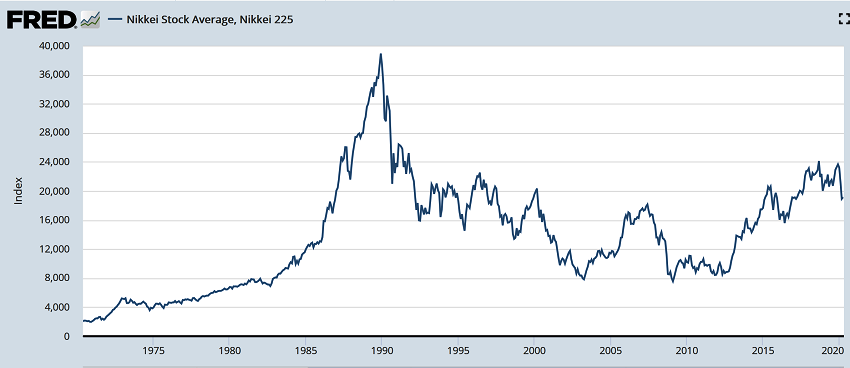
1992-2023
– Average annual GDP growth of only 0.73% - among G7
countries, only Italy had a lower growth performance. Deflation
started around 1999 and has recurred during many years.
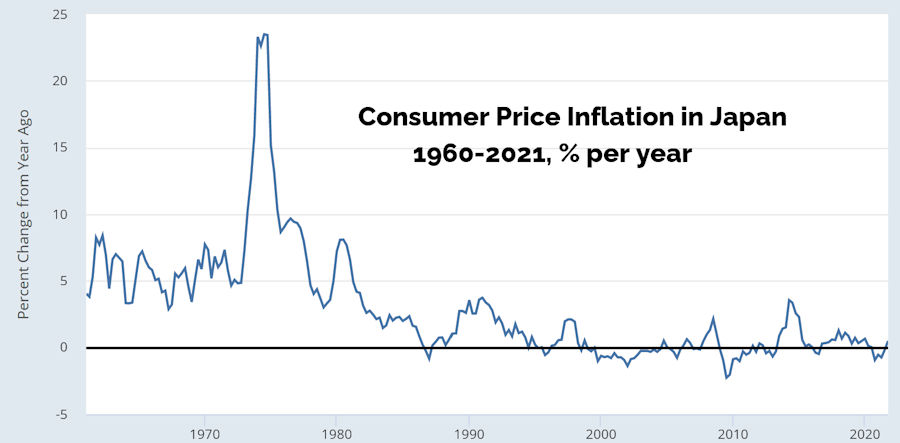
Source: OECD from FRED database (online)
December
2012
-- Shinzo Abe became Prime Minister and introduced
"Abenomics," characterized by "three arrows:" 1. Pressuring
the Bank of Japan to launch aggressive monetary easing with a
target of 2% inflation to support 2% real GDP growth; 2.
Deficit-financed supplemental government budget with new
public works spending; and 3. A program of structural reforms
to achieve growth through stimulating private investment.
However, the Ministry of Finance failed to follow a vigorous
fiscal policy, and structural reforms moved slowly. So
the main policy instrument was a late-in-the-game expansionary
monetary policy that pushed inflation above 2% in 2014, but
then it fell below 1% again afterward.
NOTE: The Japanese experience with deflation
had a major impact on the U.S. response to the 2007-2010 Great
Recession. See Ben Bernanke's
2002 speech, "Deflation: Making Sure 'It' Doesn't Happen
Here": high real interest rates, high cost of repayment in
valuable money, delayed purchases, complication of monetary
policy.
Along with deflation, the declining
population in Japan (currently falling by 400,000 per
year), caused by low fertility and marriage rates and
unwillingness to accept foreign workers, have been considered
major causes of declining economic growth.
Japan: Annual Growth of GDP
1951-2023 (%)
(actual and forecast)
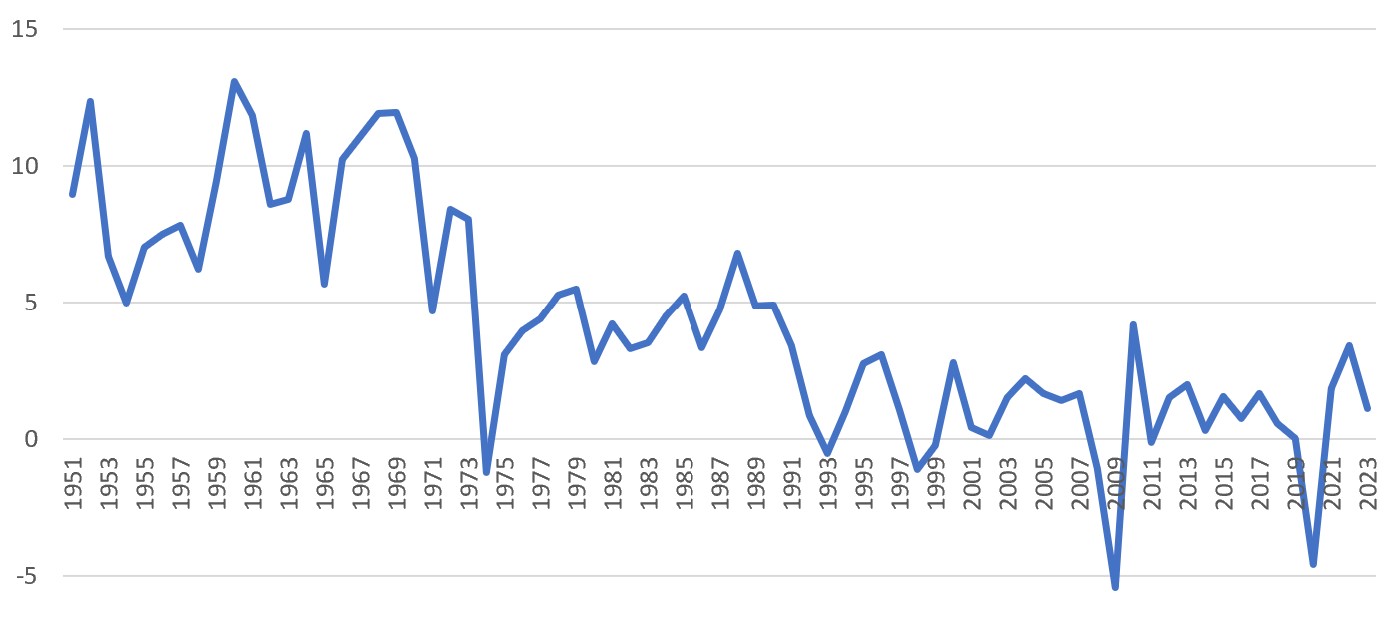
Source: Penn World Tables and OECD Economic Outlook, December
2021
Japan
and S. Korea: Working Age
(15-64) Share of Population
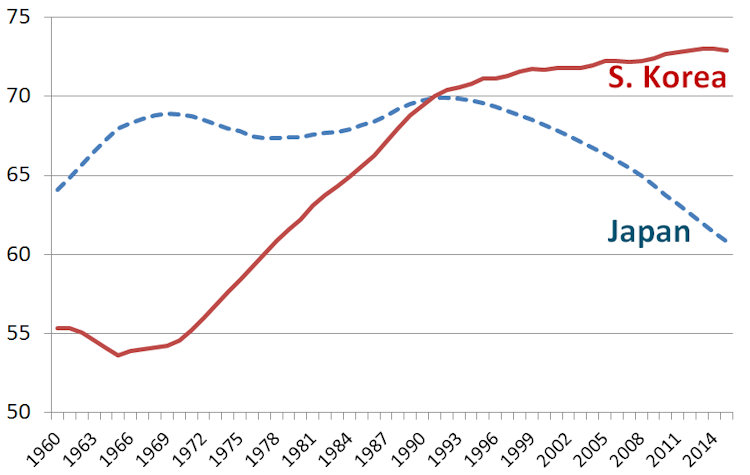
Unmarried
Women in Japan, 1965-2005
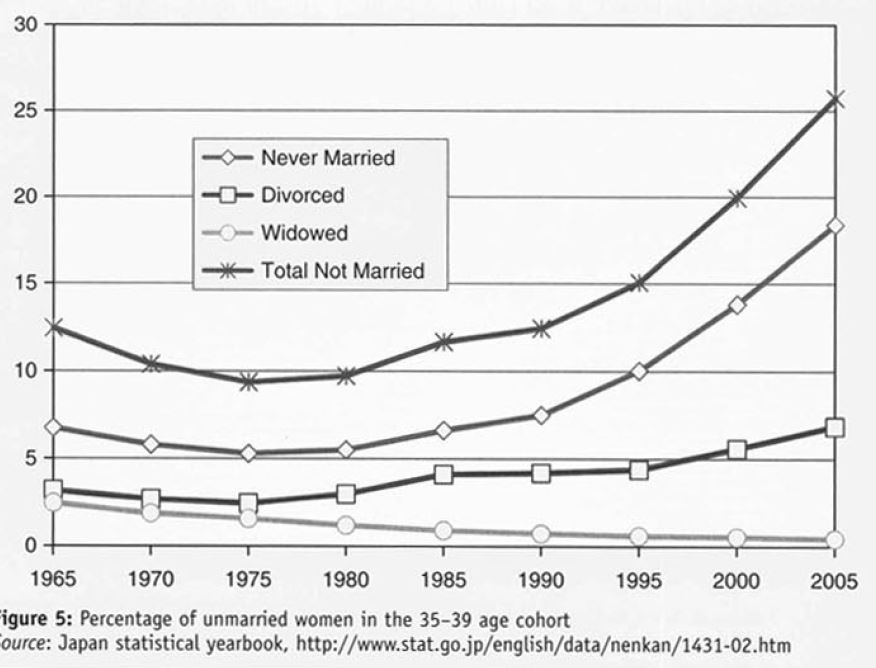
Japan
Population Forecasts
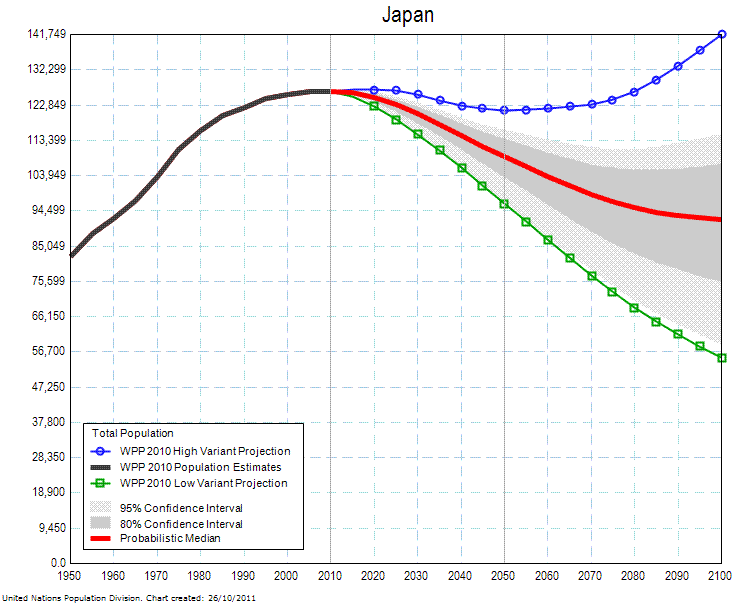
V.
Industrial Organization
A.
Big Business
1.
Zaibatsu - Family-owned holding
company controlled shares in a diversified group of industrial
corporations, trading companies, and banks. After the
war, American-written anti-trust legislation dissolved holding
companies.
2.
Keiretsu - Created after WWII,
these groups usually involve cross holdings of stock,
interlocking directorates, presidents' clubs, and other
cooperative arrangements.
a.
financial keiretsu -- Mitsui,
Mitsubishi, and Sumitomo, which were formed by regrouping
former zaibatsus, plus Fuyo (or
Fuji), Sanwa, and Dai-Ichi Kangyo—include manufacturing firms
and also banks, insurance companies, and trading companies.
b.
production
keiretsu – a large industrial concern and its
subsidiaries and subcontractors, with tight, stable
relationships, such as Toyota. Able to use just-in-time (kanban) system, shifting the
inventory cost to subcontractors.
c.
distribution
keiretsu -- exclusive organization that moves
products from manufacturers to consumers. Operating like
networks of company-controlled auto dealerships in the United
States, these are found in the automotive, cosmetic,
electrical, and electronic sectors in Japan.
3.
Results -- Japanese companies apparently did not join keiretsu
groups to earn monopoly profits, but to provide the security
and stability of a family relationship. [UPDATE]With
rising competition since the rise of China, that security
system has broken down. According to Forbes:
"The keiretsu system reached its peak in 1988 when 55% of all
floated TSE stock was held in keiretsu cross-shareholdings.
However, as Japan’s economic fortunes declined in the 1990s,
cracks began to appear and both the cross-shareholdings and
the keiretsu system began to unwind. Eventually, the keiretsu
began to diversify their supply chains and source extensively
from China and Southeast Asia."
Some of them, for example, are now supplying Apple for the
iPhone: "More than 700 companies are involved in the
manufacture of an iPhone, and unsurprisingly about half (349)
of these companies are in China. In second place, however, is
Japan with 139 firms, followed by the U.S. with 90."
While the old keiretsu system has yielded to foreign
competition, other recent
research suggests that a new, more flexible and
competitive keiretsu system has arisen. "Over the past two
decades Toyota’s suppliers’ association (kyohokai) has
remained quite stable: From 1991 to 2011 fewer than 20 of
about 200 companies withdrew. From 1991 to 2010 the average
sales-dependence ratio (the revenue from Toyota-related
business as a share of total revenue) of 44 of the company’s
suppliers has remained about 80%, even as Toyota has expanded
its sourcing pool."
B.
Small Business - 99% of Japanese
companies, employing 75% of work force, employ fewer than 100
workers.
1.
Subcontractors - 2/3 of small
firms in manufacturing. Large firms shift the cost of
holding inventories to subcontractors, and maintain their
"permanent commitment" employment by adjusting the use of
subcontracting.
2.
Retail stores - Average
store has only 4 employees. Remained small because of limited
auto ownership and bureaucratic obstacles.
VI.
Labor Market and Labor
Relations
A.
Collective Bargaining
1.
Unions - Comprehensive
enterprise-based unions, affiliated with industrial, regional,
and national federations. Labor-management disputes are
generally kept within family companies.
2.
Spring Labor Offensive -
December/January, labor federations target basic wage
increases. April, unions stage brief strikes and
demonstrations. Coordinated negotiations between
national labor and employer confederations.
B.
Lifetime Employment
1.
Coverage - Male employees in
larger corporations. About 25-30 percent of labor
force. During the 1990s, the proportion of long-tenure
(10-year plus) workers was 43% in Japan, compared to 26% in
the U.S. Women historically excluded--until recently,
participation rate during early marriage dipped below
50%. It still dips, but not as deeply, and overall
female participation has risen above U.S. levels:
Source: International Labor
Organization ILOSTAT database
2.
Benefits
a. Security and loyalty of workers who are
covered.
b. May contribute to adoption of technology
because workers have little fear of technological unemployment
and employers know their company will benefit from training.
3.
Problems -
a.
To employers--redundant, incompetent, unmotivated workers
retained, sometimes in meaningless jobs.
b.
To young employees--difficult to leave for a more attractive
job.
c.
To older employees and workers not included in system--
greater job uncertainty.
d.
For these and other reasons, the conventional wisdom has
suggested that the system was in decline, but 2015
research by Japanese authors suggested that it has changed
very little while employment has grown more insecure in
the U.S.
UPDATE:
Wall Street Journal, 4/11/2018: More people are
switching careers at for new opportunities, and more companies
are willing to hire them because of scarce talent, however:
"many companies resist the idea of midcareer job-switching...
The number of employees switching jobs annually is still less
than 5% of the Japanese workforce. In 2016, the average worker
in Japan had been at one company for about 12 years, compared
with an average 8.6 years in the U.K., according to official
data. The U.S. Bureau of Labor Statistics doesn't report
average employee tenure, but the median U.S. figure was 4.2
years in 2016. "Employees will see their salary more than
double if they continue working for 20 years, so they don't
have the incentive to think about changing jobs," said Ryo
Kambayashi of Hitotsubashi University. .
C.
Seniority Pay - Wages are
determined largely by the length of service of the
employee. Reinforces employee interest in lifetime
employment, but reduces employer interest. System is in
decline.
D.
Bonuses - Account for 20% of pay
in manufacturing. Significance:
1.
Employee motivation.
2.
Saving - If the bonuses are
regarded as transitory income, permanent income hypothesis
suggests that a large portion of the bonus income will be
saved.
3.
"Share Economy" - Weitzman
claims that bonus system explains low Japanese
unemployment. In share economy, profit maximizing
employers would expand employment and output until "every
qualified person" has a job. Critics say that bonuses are
negotiated in advance, so they aren’t true share contracts,
and that Weitzman's theory cannot explain the Great Depression
and takes little account of expectations or uncertainty.
VII.
The Financial Sector
A.
Ministry of Finance (MOF)
-- exceptionally broad authority, including influence over
fiscal and monetary policy and informal
administrative
guidance
of financial institutions. Reformers wish to reduce its power.
B.
Bank of Japan
-- central bank, led by seven-member Policy Board, is formally
independent, but informally subject to the MOF. Because
securities markets developed slowly, the Bank uses discount
lending, rather than open market operations, as its primary
tool, and uses it to support industrial policy through moral
suasion, or window
guidance,
of banks.
C.
Commercial banks –
provide large share of company financing, again, because
of limited securities market.
1.
City
banks
-- among most powerful financial institutions in the nation,
with nationwide branches. Serve large and upper-middle-sized
corporations.
2.
Regional banks --
branches in single city or prefecture. Serve small and
lower-middle-sized companies.
D.
Long-term credit banks -- underwrite securities and
finance fixed capital investments
VIII.
The Government
A.
Views of Governmental Role
1.
Conservatives - Point to conventional measures of government
influence, such as taxation, and claim that the Japanese
success was based on a limited government.
2.
Japan, Inc. - Government is "corporate headquarters" where
policy is planned and investment decisions are made.
Understates the influence of the business community on the
government.
B.
Economic Planning - The Economic
Planning Agency solicited proposals from business, labor,
government, and academia. It provided information and
improved communication between all segments of the
economy. Adherence was voluntary. Targets were exceeded
in 1960s and during the Bubble era, but underfulfilled in
1970s and 1990s. In 2001, the Economic Planning Agency
was merged into a new Cabinet Office, and particularly its
Council on Economic and Fiscal Policy, that serves as a "brain
trust" for the Prime Minister.
C.
Industrial Policy - Administered
(far less aggressively than in the past) by Ministry
of Economy Trade and Industry (the former Ministry of
International Trade and Industry. Designates industries for
priority development based on growth potential and
contribution to growth of other sectors.
1.
Proponents - Japanese success required governmental direction,
support, and socialization of risk.
2.
Critics - Japan succeeded in spite of industrial policy.
MITI picked corporations like Sony and Honda as
"losers". MITI is not as powerful as it seems. Tax
concessions are not as important in a system of low tax
burdens and only a small portion of industrial investment is
financed by government money. In recent years, pressure
has mounted for deregulation and less cronyism.
D.
Fiscal, Monetary, and Trade Policy
- Monetary and fiscal policy are normally directed by Ministry
of Finance. Budget approved by the cabinet and the
Diet. Monetary policy is executed by the Bank of Japan,
and has generally been accommodative.
E.
Redistribution of Income -- Rapid
economic growth caused property income to rise rapidly,
causing income some inequality. However, the World Bank
estimate of the Gini coefficient for Japan is a relatively
egalitarian 33%- similar to those for France and Germany.
Perhaps explained in part by a cultural norm against high
executive pay. Median compensation for U.S. CEOs is 9
times larger than for Japanese CEOs.
1.
Taxation - Has a relatively small
role in income redistribution. Personal tax rates are
highly progressive, an unusually large proportion of tax
receipts come from business profit taxes, and a small
proportion comes from the regressive consumption tax.
Furthermore, the overall tax burden is relatively light.
2.
Transfers - Traditionally, the
government paid relatively little attention to income
redistribution because families and businesses took care of
their own. That changed dramatically with social welfare
expenditures related to the Covid crisis and rising Social
Security costs for the aging population.
|
